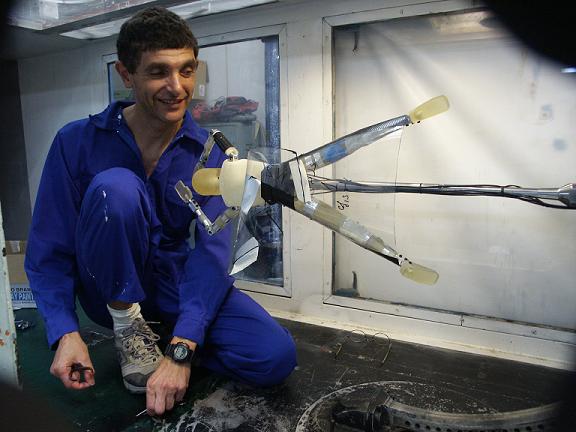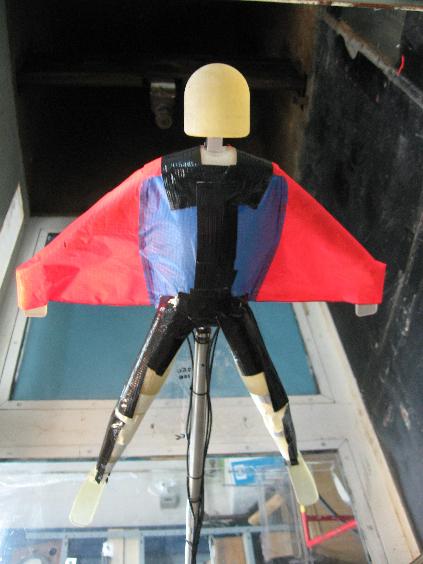This is the first time in the world that there is a scientific design for suiting wings. So far, such suits have been built on a trial and error basis

Students in the Faculty of Aeronautics and Space Engineering at the Technion designed a wing suit for a pilot who wants to fly without an airplane, better than all the suits on the market today.
"Until now, adventurers would sew their own suits based on trial and error," says Yair Segev, one of the students who participated in the project led by Professor Gil Yosilevsky. “As many of them have discovered, poor suit design is almost always fatal. We wanted to prove that the suit could be designed without risking human life while improving the existing performance. To the best of our knowledge, this is the first time in the world that there is a scientific design for suiting wings."
Three main limitations are faced by the jumpers: loads on the limbs, the stability of the suit and reasonable driving ability. The students assumed that in order to engage in extreme sports, the parachutist must be in excellent physical shape. After consulting with the head instructor at the Technion's gym, they determined exercises that could be done to simulate the loads on a real parachute. They sent able-bodied friends to the gym to test their limits.
"We discovered that for certain loads, parachuting is no longer fun but torture for the parachutist," they say. "After defining the physical limitations of the parachute, we built an abstract aerodynamic model of a person flying in a suit. Using the model, we estimated the size of the wings and tail, which ensure stability on the one hand and meet the load limits we measured earlier."

In the second phase, the students built a model of a person for experiments in a wind tunnel. Gauges were inserted inside the model that measured the loads that act on the limbs separately and on the whole person in "flight" in the wind tunnel. After studying the models, many ideas that were raised at the beginning of the journey were "thrown away", such as flying with hands in the form of "Superman" or like a flying squirrel which is not suitable for the human body due to the large loads. After about a hundred experiments, careful filtering and many changes, the students arrived at an ideal suit - one that is both stable, manageable and has good performance.
"We entered the results of the experiment into a computerized database," says Yair Segev. "We connected the base to a flight simulation software where we flew a plane with the aerodynamic properties of a man in a suit - he is the pilot without a plane (TLM). Using the software, we tried to feel how a parachutist would feel if he flew with our suit and how much he would have to sweat to perform simple maneuvers. We defined a number of tasks for ourselves and tried to assess the level of difficulty in performing them according to the rating accepted in the aviation world. Our conclusion was that only a professional pilot can fly with the suit, but with our suit he will be able to reach a much greater distance than can be reached with the existing suits on the market."
The other five students who participated in the project are: Yoav Green, Yafim Yablochkin, Leon Mintz, Omer Naaman and Roman Levin.

22 תגובות
A central "point" in the treatise.
Is it better than redbull? Why didn't they turn off the comparisons?
Do not need.
To the cute elf..
It's true that you suddenly feel at home with the title of Odin, the Norse god known for his exploits, and his two ravens
The magical.. an ancient thought and memory??
Well, there are plenty more in the pantheon.
Hugin and Monin, if I may ask, where does your nickname come from? From Tolkien and his sources?
To a student
We found the "Selectron"! Yes!
Hugin..
up yours
best wishes...
The Dark Knight, of course:]
Oh, how old-fashioned you are...
In 2005, I already obtained a "memory cloth" that enables all these things!
Soon, an aviation jet club from Neshav - to innocence.
The subject: object.
aeronautics *
:0
How cool for you :)
Interesting project, aeronautics Rolls:]
Need a source
To Hugin, what to do human pilots also need a tail for their aircraft
(F16, 747.. whatever you say) without the tail of the legs (or any rear part
of the aircraft - even if the aircraft is the pilot himself) will sink and start
A phenomenon (followed by a painful fall) known in Hebrew as "getting up".
to my people,
Very important for navigation.
Especially for dragons.
Small on me
need a tail
I would fly farther, in the direction of the human supermen, with the acceleration incentive - diminishing.
(And an easy hint that easy: on the threshold of the paradoxical ability-a possible discovery emerges).
It is recommended to open the wings of the heart first.
We'll wait and see.. who will indeed raise a chicken. Even in mutual respect.
So, in the meantime, good luck to the "winged ones", the contemporary Daedalus, in the article.
I think they are really influenced by the movie Iron Man
What can I tell you good luck 🙂
BS looks primitive - Batman's suit should be an inspiration in both technology and appearance
Larnon,
Weight, maneuverability, and maybe also comfort.
If you use composite material, and with a hinge or two, you can do it, but then there is also a price factor. How much does all the fabric cost for a suit like this? I think a rod will cost about the same as the suit, if not more...
And by the way, what about the fabric really? It sure has an effect on the suit
Why not use a minimal exoskeleton (one transverse bar for example), this will greatly reduce the load on the muscles and allow for a significant increase in the area of the wings.
What part of. Just today I saw a show about extreme sports gadgets and there was also a wingsuit on there. I was first exposed to this item today, from two different sources.